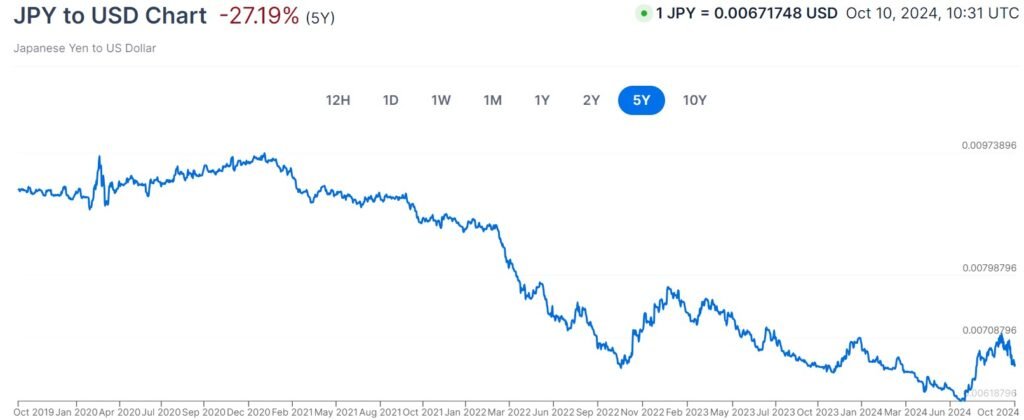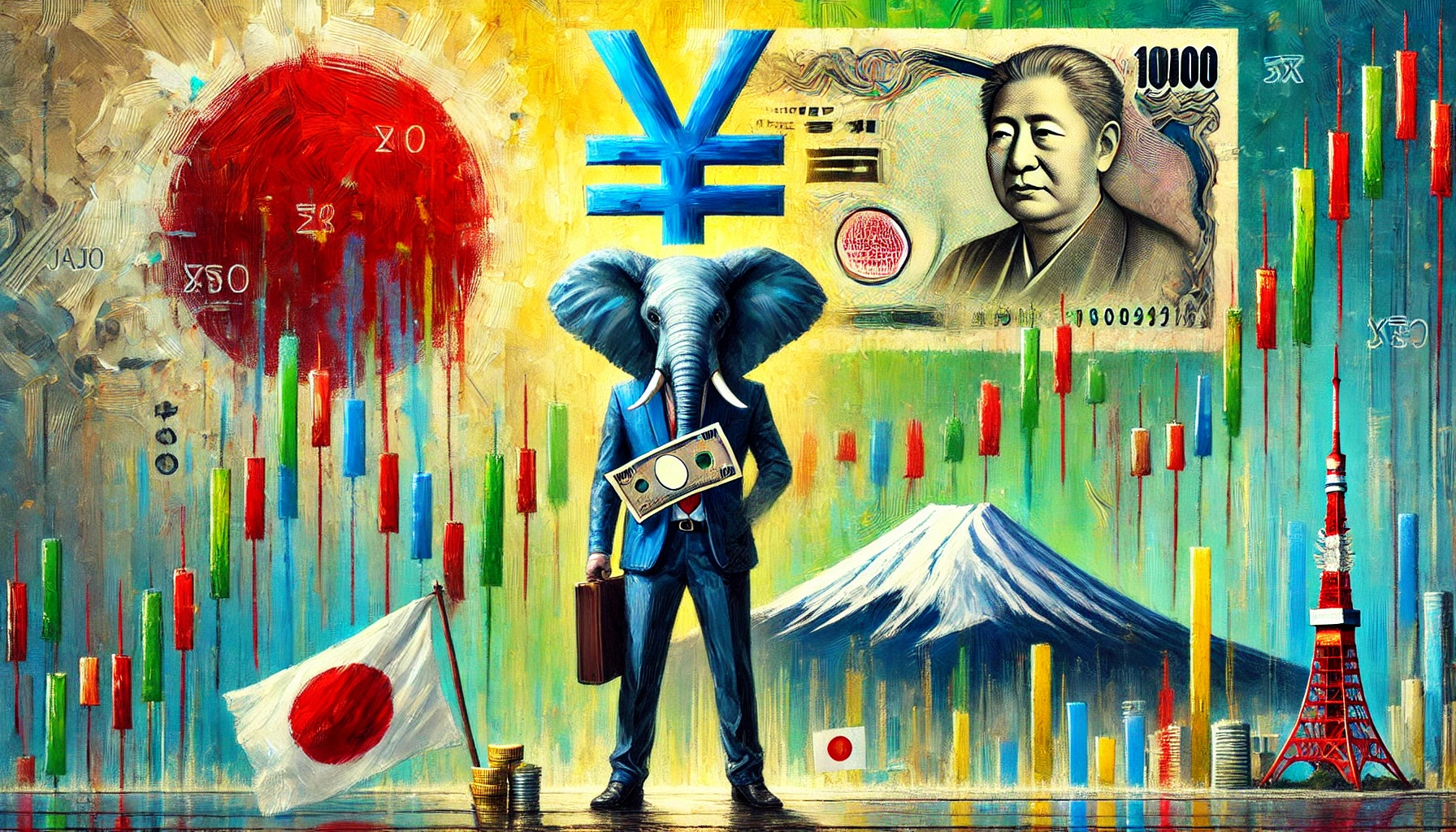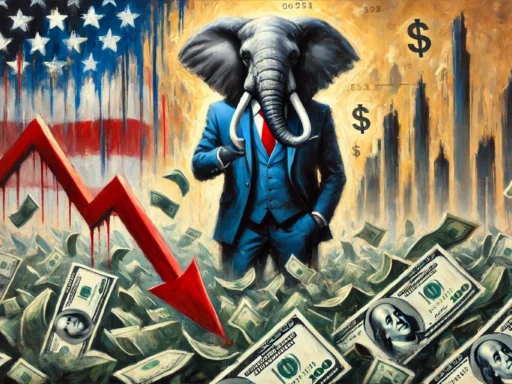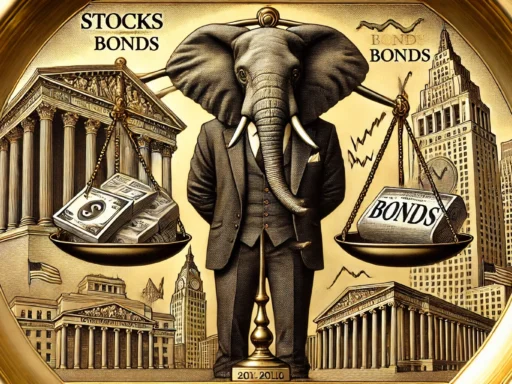Hello Elephants!
The Japanese yen has been on a wild ride lately, hitting its weakest level against the U.S. dollar in nearly 40 years. For forex traders, understanding the forces behind this currency’s swings is more crucial than ever. In this article, we’ll explore why the yen is weakening, how Japan’s economic conditions and global events are shaping its future, and what this all means for your forex trading strategies. Whether you’re a seasoned investor or just starting to dip your toes into forex, this is a journey you won’t want to miss.
The Yen’s Recent Decline
The Japanese yen has recently hit record lows, with its value against the U.S. dollar plummeting to levels not seen since 1986. In July 2024, the yen fell to ¥161 per dollar, a striking low that caught the attention of traders and policymakers alike. While the Bank of Japan (BOJ) took action to raise interest rates for the first time in 15 years to slow the decline, this move provided only temporary relief, as uncertainty still clouds the currency’s future.

What’s driving this dramatic fall? Economists, like Mizuho Securities’ Miyoko Nakashima, believe we’re seeing the beginning of a long-term devaluation phase. She notes that the yen tends to move in 25-year cycles, and we may have entered a new phase where the currency will continue to weaken for some time. Japan’s sluggish economic growth, widening interest rate gap with the U.S., and trade imbalances are all playing a part in this trend. As Nakashima explained at the Rakuten Optimism Conference:
“From 2022, the U.S. began raising interest rates rapidly. And that’s where this long-term trend of the weakening yen began, which is where we are now.”
Source: Rakuten Optimism: What’s Going On With the Weak Yen?
For forex traders, this presents both opportunities and risks. As the yen fluctuates, it creates chances for profitable trades, but traders must stay cautious, as interventions and unexpected economic events could quickly shift the currency’s direction. Understanding how these cycles work can help traders position themselves better in the forex market.
(For more on understanding how currencies move in response to these factors, see our guide on How to Read Forex Charts.)
Why is the Yen Weak?
Several key factors are behind the Japanese yen’s recent weakness, with most of them tied to the country’s economic situation and its relationship with the U.S. Let’s break it down simply.
First, economic growth disparity is a major reason. Since the 1990s, the U.S. economy has grown faster than Japan’s. Stronger economies tend to have more attractive currencies because investors prefer to hold their money in places where it can grow faster. This shift has made the dollar more appealing than the yen. As Miyoko Nakashima pointed out:
“In the 70s and 80s, Japan had stronger growth than the U.S.… but since the 1990s, the U.S. has had stronger growth.”
Source: Rakuten Optimism: What’s Going On With the Weak Yen?
Second, there’s the interest rate gap between the two countries. The U.S. has been raising its interest rates rapidly since 2022, while Japan’s rates have remained very low. This difference makes U.S. investments more attractive, pulling money out of Japan. Nakashima highlighted this point at the Rakuten Optimism conference:
“This difference in interest rates almost exactly matches the movement of the yen against the dollar.”
Source: Rakuten Optimism: What’s Going On With the Weak Yen?
Although the Bank of Japan raised rates in 2024, it hasn’t been enough to close the gap significantly, leaving the yen vulnerable.
Finally, there’s Japan’s trade deficit. Since 2022, Japan has been importing more than it exports. This means more yen is being sold to buy foreign goods, which weakens the currency further. With Japan relying heavily on imported energy and other goods, this trend shows little sign of changing soon. Nakashima summarised it well:
“From a supply and demand perspective, with this as a long-term trend, there is barely any structural reason for the yen to grow stronger.”
Source: Rakuten Optimism: What’s Going On With the Weak Yen?
For forex traders, it’s crucial to watch these economic indicators. The yen’s weakness creates opportunities for certain strategies, but traders need to stay alert to changes in the global economic landscape.
(If you’re new to forex, be sure to check out our guide on What is Forex? to better understand how these factors affect currency trading.)
How the Weak Yen Affects Forex Traders
The yen’s weakness has a ripple effect across Japan’s economy, affecting businesses and creating opportunities and risks for forex traders. Whether you’re trading yen pairs or following the broader forex market, understanding these dynamics can help you stay ahead of the game.
For export-heavy businesses, a weak yen can be a blessing. Japanese companies that sell goods abroad, like car manufacturers or electronics firms, benefit because their products become cheaper for overseas buyers. This can boost their sales and profits. On the other hand, import-heavy businesses, especially smaller companies that rely on foreign goods, feel the pinch. When the yen weakens, it costs more to buy the materials and products they need from abroad, squeezing their profit margins. As Miyoko Nakashima explained:
“For smaller companies, many of whom work with domestic demand, a weaker yen means higher costs, putting pressure on business performance.”
Source: Rakuten Optimism: What’s Going On With the Weak Yen?
For forex traders, this environment can present exciting opportunities. The yen’s volatility creates more chances for profit, as traders can take advantage of its frequent fluctuations against other currencies. However, it’s important to tread carefully. The Japanese government has been known to step in and intervene in the forex market to prop up the yen, as seen during multiple interventions in 2024. These moves can cause sudden, sharp shifts in the yen’s value, catching traders off guard. As one market strategist noted:
“The dollar is responding to fundamentals as we would expect – softer CPI, lower U.S. rates, and of course dollar/yen falls… I think the market got caught leading the wrong way.”
Source: Reuters: Yen Surges Amid Intervention Speculation
To navigate these ups and downs, many traders look at the historical cycles of the yen. As mentioned earlier, the yen tends to move in 25-year phases, shifting from periods of strength to weakness. Understanding these long-term cycles can provide insights into where the yen might head next. While we’re currently in a phase of devaluation, traders should watch for signs of change, like shifts in interest rate policies or global economic crises, which could reverse the yen’s downward trend.
To sum up, the weak yen offers both opportunities and risks for traders. While volatility can be a trader’s friend, staying informed and keeping an eye on market interventions is key.
(For more details on how currency movements impact your trading, check out our guide on The U.S. Dollar Losing Value and Its Impact on Forex Trading.)
What Might Reverse the Yen’s Decline?
Although the yen has been weakening steadily, several factors could potentially reverse its decline, at least temporarily. For forex traders, keeping an eye on these possibilities can help them anticipate market movements and adjust their strategies accordingly.
One of the biggest factors that could impact the yen is interest rate cuts in the U.S.. Over the last few years, the U.S. has been raising interest rates much faster than Japan, which has widened the gap between the two currencies and pushed the yen lower. However, if the U.S. starts cutting rates in the near future, this could narrow that gap. With less of a difference in returns between U.S. and Japanese assets, investors might move back towards the yen. As Miyoko Nakashima noted:
“The U.S. is headed towards interest rate cuts, while Japan is headed for rises – the exact opposite. This would reduce the rate disparity, leading to a stronger yen and weaker dollar.”
Source: Rakuten Optimism: What’s Going On With the Weak Yen?
Another factor that could reverse the yen’s downward trend is market intervention by Japan’s government. The Ministry of Finance and the Bank of Japan have already stepped in multiple times in 2024 to prop up the yen when it fell to dangerously low levels. This intervention can have a significant short-term impact, causing the yen to strengthen quickly. As currency strategist Paula Comings observed:
“There are opportunities to enter into options-based strategies at favourable rates and/or prices to either buy or sell JPY.”
Source: Reuters: Yen Surges Amid Intervention Speculation
Finally, global events, such as recessions or financial crises, can also strengthen the yen. Historically, the yen is seen as a “safe-haven” currency, meaning that during times of crisis, investors flock to it for stability. If a major global event, like a recession in the U.S. or Europe, were to occur, demand for the yen could increase. As Nakashima explained:
“One perspective is that demand for yen often jumps in times of crisis… a risk event could see the sell-off reversed.”
Source: Rakuten Optimism: What’s Going On With the Weak Yen?
For forex traders, these potential scenarios offer both risks and opportunities. Staying informed about global economic trends, interest rate decisions, and potential market interventions will be crucial for anyone trading yen pairs.
Key Strategies for Forex Traders
The yen’s current weakness presents forex traders with both opportunities and challenges. To navigate this landscape effectively, it’s important to adopt strategies that balance risk with potential reward. Here are a couple of key strategies that traders should consider when dealing with the Japanese yen.
One approach is the carry trade strategy, which is popular when there’s a significant gap between interest rates in different countries. In a carry trade, traders borrow in a low-interest currency, such as the yen, and invest in a currency with higher interest rates, like the U.S. dollar. Since Japan’s rates have been low for years, the yen has often been a prime candidate for this strategy. However, carry trades are not without risk—especially when market interventions or sudden changes in interest rates occur. As currency strategist Marc Chandler pointed out:
“The yen story has been a rate differential story… when that rate differential erodes, traders need to reassess their positions.”
Source: Reuters: Yen Surges Amid Intervention Speculation
Another key strategy is yen hedging. With the yen’s value fluctuating, hedging against potential losses can protect traders from adverse movements. Forex traders can use options and futures contracts to lock in exchange rates and shield themselves from sudden shifts in the yen. This strategy becomes particularly valuable when there’s a high chance of intervention or unexpected market movements. As Paula Comings of U.S. Bank noted, this is an area traders should watch closely:
“Options-based strategies at favourable rates… can help traders hedge against both long JPY revenues and short JPY expenses.”
Source: Reuters: Yen Surges Amid Intervention Speculation
Finally, monitoring monetary policies in both Japan and the U.S. is essential for anyone trading yen pairs. Changes in interest rates are the biggest drivers of the yen’s movements, and staying informed about decisions from the Bank of Japan and the Federal Reserve can give traders an edge. As the U.S. moves towards possible interest rate cuts and Japan slowly raises its rates, this narrowing gap could shift the yen’s value significantly. Savvy traders will keep a close watch on these developments and adjust their strategies accordingly.
In essence, trading the yen requires a combination of risk management and awareness of global economic trends. Whether through carry trades, hedging, or simply keeping an ear to the ground for monetary policy changes, forex traders can position themselves to make the most of the yen’s volatility.
So what now?
At the end of the day, Elephants, the journey of the Japanese yen is like a winding path through the jungle—full of twists and turns shaped by global events, interest rates, and Japan’s economic landscape. For those of us in the herd navigating the forex market, the yen’s ups and downs offer both opportunities and challenges. By staying alert to shifts in interest rates and economic policies, and using strategies like carry trades and hedging to manage risk, we can tread carefully through the uncertainty and still find our way to profit.
As we continue along this path, it’s clear the future of the yen is far from settled. Global events like U.S. rate cuts or Japan’s government interventions could shift the market quickly, while unexpected crises might strengthen the yen in the blink of an eye. But with the right approach—keeping our eyes wide open and adapting to the terrain—we can make smart, informed moves. Stick with the herd, stay informed, and you’ll be ready for whatever the market throws your way.






